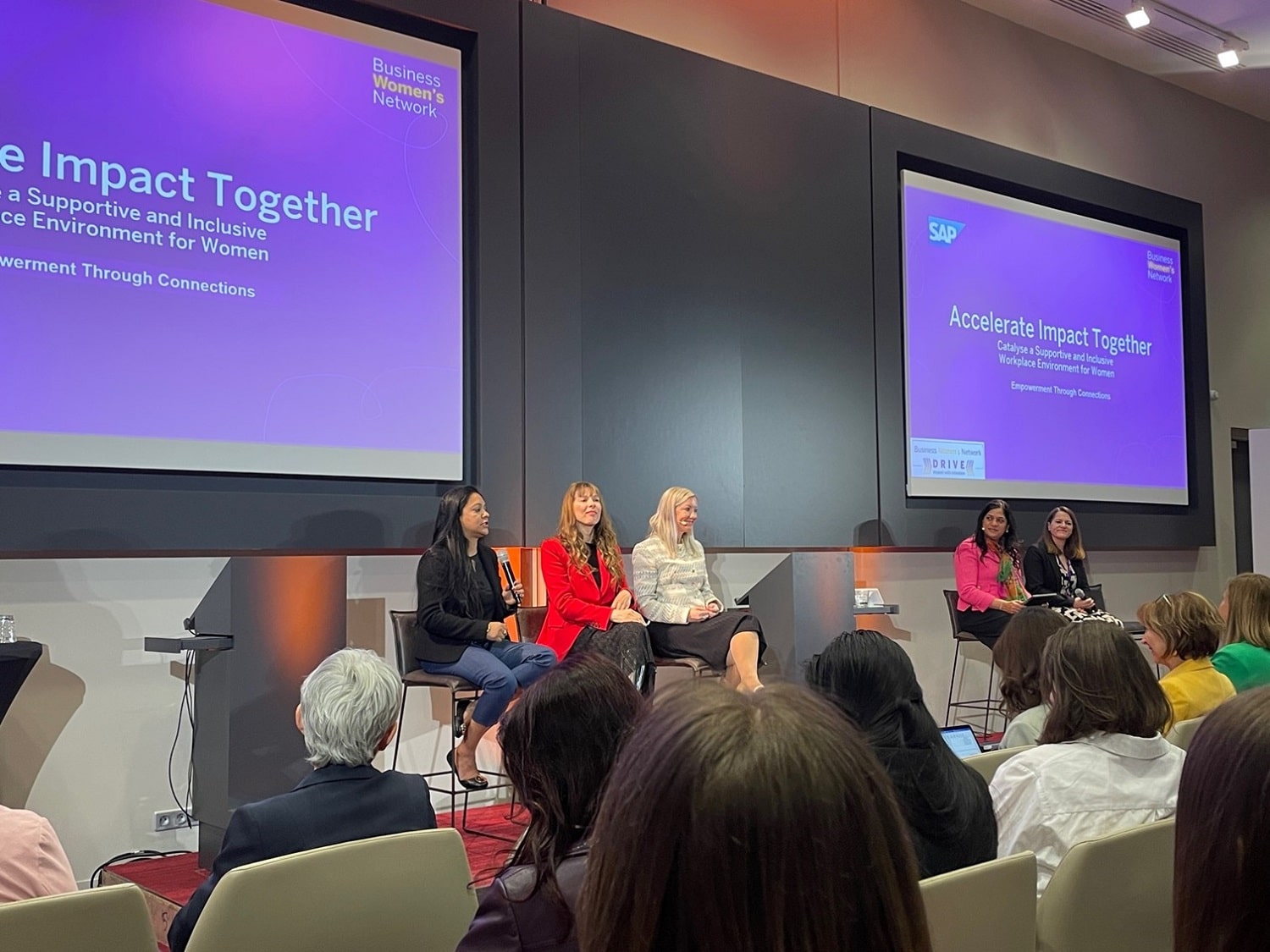A panel of diversity and inclusion (D&I) leaders from Merck, Airbus, Schneider Electric, and SAP gathered at the fifth annual Business Women’s Network (BWN) Global Leadership Summit and shared the strategies their companies use to create workplace environments where everyone can thrive.
“Diversity and inclusion, in practice, is a matter of continuous learning. Change is rapid — in the world and in technology — and we need to be intentional in putting in the effort to consider diversity in everything that we do.”
– Supriya Jha, Chief Diversity and Inclusion Officer at SAP SE.
“Our ambition is to become the place to be for all, where everyone has a voice and belongs, regardless of abilities, nationality, background, gender, age, and any other factor,” said Caroline Sehn, Diversity, Equity & Inclusion lead at Merck. “We truly believe that it will help our success in innovation, technology, and creativity as diverse minds, as well as to become digital enablers for the business, building a workplace accessible and inclusive for all.

The rest of the panel agreed with the sentiment, and unanimously agreed that one of the best ways to ensure that D&I does not fall by the wayside is with data and key performance indicators (KPIs), as is standard practice with other business goals.
360-Degree Approach to D&I at Airbus
Airbus is the largest aeronautics and space company in Europe and a worldwide leader in the aviation industry with more than 130,000 employees. Within the Digital organization, the percentage of women is 25%, a bit higher than the market average of 24%. A strong commitment to raise awareness of younger women and encourage them to pursue digital careers through activities such as special events and mentorship is coordinated in partnership with various associations such as Elles bougent in France.
Célia Frey, vice president and head of Information Management for Programs, Customer Engagement & Services at Airbus, explained that the company thinks of diversity from five key perspectives: gender parity, LGBTI+ inclusion, equal opportunities for people with disabilities, accommodating generational gaps, and contributing to the economic and social development of underprivileged neighborhoods.
On gender parity, for example, Airbus is committed to the United Nations objective of developing women in business and having women in 25% of executive positions in 2025, where the starting situation was 14%.
Airbus also has a program called Generation A, which aims to bridge the gap between the multiple generations its employees span and a “support an employee” network called Balance for Business, which helps all employees balance work with life commitments and promote gender equity.
Digitall: Inclusive and Diverse Place for All at Merck
Merck KGaA, a leading science and technology company operating across healthcare, life science, and electronics sectors, recently announced a strategic partnership with SAP to jointly drive sustainable business practice innovation and digitalization. The company has a goal of gender parity by 2030. To reach this ambition, Merck IT has launched a campaign to help break down stereotypes around gender, nationality, age, family situations, and personal goals.
Sehn says that Merck CIO Alessandro de Luca is refreshingly honest in acknowledging that IT used to be a male-dominated industry, but now and in the future will need all talents to drive innovation and digitalize the business. Merck IT offers agile work processes and good work life-balance with flexible working hours. There are also mentoring campaigns, talent development, and career training opportunities that enable employees to establish share learnings and establish support networks.
Schneider Electric’s Strategy for Inclusion and Care by Design
As a leader in the digital transformation of energy management and automation, Schneider Electric also aims to be the most inclusive and caring company in the world. To execute on that vision, the company has created Inclusion and Care by Design, the philosophy to build inclusion and care into all process and elements of company culture.
Julie Ashton-Howorth, group chief accounting officer at Schneider Electric, explained that all company processes — whether they involve employees or customers or both — feature end-to-end accountability that helps ensure every individual feels respected and safe to be their unique self.
One of the things Schneider Electric has done to promote diversity in leadership is move away from a single headquarters model to a multi-hub structure that better serves the communities where the company operates. It also transparently shares its journey, progress, processes, and commitments, and co-creates with employees, customers, suppliers, and NGOs to be a truly responsible corporate citizen.
“Diversity is being invited to the party.
Equity is ensuring everyone can get to the dance, regardless of their starting location.
Inclusion is being asked to dance together.”
– Julie Ashton-Howorth
D&I Center of Excellence at SAP
SAP Chief Diversity and Inclusion Officer Supriya Jha explained that the company has invested internally and externally in programs that help existing and potential female employees grow and thrive in their careers. For example, there is a D&I center of excellence that reports to the SAP Executive Board monthly, and houses a data analytics team that monitors the internal and external KPIs related to female progression and provides insightful data to hiring, learning and development teams, and the SAP leadership team, so that they can take intentional steps to retain and advance women at SAP.
While its ultimate goal is to attain gender parity, SAP is proud to have achieved a milestone goal of 35% women in its workforce and is seeing an increase in the number of women in managerial ranks from 25.5% in 2017 to 29.4% at the close of 2022. In addition, in 2023, SAP was reinstated to the Bloomberg Gender-Equality Index, which recognizes a commitment to advancing women in the workplace.
All panelists acknowledged that there is more to be done to achieve gender parity and other diversity goals, but they felt positive. Sehn summarized the sentiment: “As the old Buddhist saying goes, ‘One candle can light thousands.’ We need to keep this in mind when we’re working together.”



